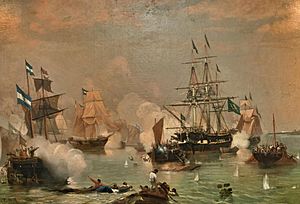Battle of Monte Santiago facts for kids
Quick facts for kids Battle of Monte Santiago |
|||||||
|---|---|---|---|---|---|---|---|
| Part of the Cisplatine War | |||||||
 Battle of Monte Santiago, oil on canvas by Edoardo de Martino |
|||||||
|
|||||||
| Belligerents | |||||||
| Commanders and leaders | |||||||
| Strength | |||||||
| Ships: 1 frigate 2 corvettes 5 brigs 8 schooners 1 lugger 1 patache Total guns: 229 |
Ships: 1 corvette 2 brigs 1 schooner Total guns: 65 |
||||||
| Casualties and losses | |||||||
| No ships lost 1 brig heavily damaged 30-40 killed or wounded |
2 brigs sunk 1 schooner damaged 54 killed 160 wounded |
||||||
The naval Battle of Monte Santiago was a big fight between the Argentine Navy and the Imperial Brazilian Navy. It happened on April 7–8, 1827, during the Cisplatine War. Brazil won this battle, which was a major loss for Argentina's navy.
Argentine historians remember this battle as one of the bravest and fiercest naval fights in their country's history. During the battle, Captain Francis Drummond died. He was engaged to Admiral Brown's daughter, Elisa. He chose to keep firing his ship's cannons instead of giving up.
This defeat was a serious problem for the smaller Argentine Navy. After this, Argentina's navy could only do privateer raids against trade ships. The Brazilian Navy kept a naval blockade on Buenos Aires, which caused big problems for Argentina's economy.
Contents
What Happened at the Battle of Monte Santiago?
The Brazilian Navy had large ships. These ships had more powerful guns but were slower. The Argentine Navy used faster ships that could move quickly. Some Argentine commanders thought their fast ships could win battles in shallow waters. They believed the bigger, slower Brazilian ships would struggle there.
The Argentine Squadron
The main ships in the Argentine squadron were:
| Vessel | Type | Captain |
|---|---|---|
| Republica Argentina | Brig | William H. Granville |
| Independencia | Brig | Francis Drummond |
| Congresso | Corvette | William Mason |
| Sarandí | Schooner | John Halstead Coe |
The Argentine commander, Admiral Brown, thought he could surprise the Brazilians. He believed his faster ships could cause damage and then escape. However, he didn't know that the Brazilian fleet had many more ships. On the first day, Brazil had three times more ships. By the second day, they had four times more. Brown also didn't realize the Brazilians could block his escape routes. Because of this, the battle became a two-day attack on his men.
The Fight Begins
At night, Admiral Brown left the harbor with his ships: the Republica, Independencia, Congreso, and Sarandí. A Brazilian lookout ship, the Maceió, saw them. It warned the rest of the Brazilian fleet using cannons and signal lights. Other Brazilian ships quickly moved to intercept.
The Argentine ships tried to reach the open ocean. Around 2 AM, the Brazilians started firing. They tried to trap the Argentine ships between their own line of ships and the coast. The Maceió chased the Congreso, which left the main line and tried to hide in Ensenada. The Independencia and the Republica also turned. They ran aground (got stuck) in shallow waters. The Sarandí stayed with them to help defend.
The battle, with cannons firing and ships trying to rescue or destroy each other, lasted for hours. By 7 PM, Admiral Pinto Guedes' main squadron arrived. Only two of his smaller ships, the Pirajá and the Independencia ou Morte, could get close to the grounded Argentine ships.
The Final Attack
During the night, the wind changed. This allowed six small Brazilian schooners (a type of ship) from Colonia to sail into the shallow waters. The Brazilians prepared their final attack on the stuck Argentine ships. The larger Brazilian ships blocked any escape route. The schooners surrounded the Argentine ships. They fired their cannons until 2 PM the next day. Then, they boarded the Argentine ships.
The Independencia surrendered. The Republica fought bravely but was eventually taken over. Admiral Brown, who was wounded in his leg, moved to the Sarandí and returned to Buenos Aires.
What Happened After the Battle?
Argentina lost many ships in this battle. They had also lost a large ship, the 25 de Mayo, in the Battle of Quilmes earlier (July 29–30, 1826). These losses meant the Brazilian Navy kept control of the River Plate.
After Monte Santiago, the Argentine Navy could only carry out small raids against trade ships. Most of these raids started from their base at Carmen de Patagones on the Atlantic coast. They could no longer challenge the larger Brazilian Navy ships in big battles. As military historian Brian Vale said, Argentina's navy was severely weakened.
The war then reached a stalemate. The Argentine Army was doing better on land. However, they couldn't force the Brazilian Army out of Colonia del Sacramento and Montevideo. These two major cities in Uruguay stayed under Brazilian control throughout the war. Argentina also didn't have big enough ships to control the river. At the same time, the Brazilians had suffered losses in earlier battles. This made them not want to fight further up Argentina's rivers. The shallow waters also made it hard for them to attack Buenos Aires directly.
This situation continued until 1828. That year, the Preliminary Peace Convention was signed. This treaty made the Cisplatina Province an independent country, which is now Uruguay.
See also
 In Spanish: Batalla de Monte Santiago para niños
In Spanish: Batalla de Monte Santiago para niños

